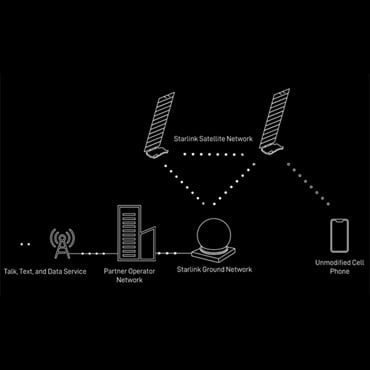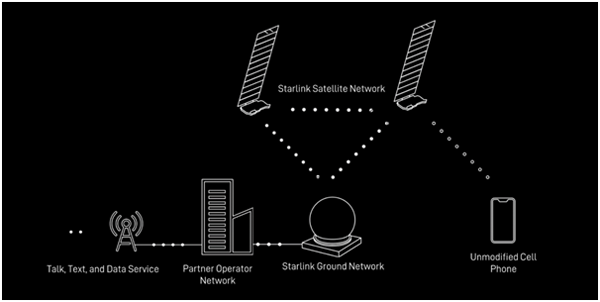Starlink aims to provide satellite internet connectivity to underserved and remote areas worldwide, where internet access has traditionally been limited or non-existent. The global network of Starlink satellites in Low Earth Orbit (LEO) will be providing a new ‘Direct to Cell‘ service to deliver a 4G mobile service to standard Smartphones. Once the Direct To Cell service is fully up and running, the number of satellites will have increased significantly, and more powerful SpaceX V2 satellites will have been deployed. In essence, users can always access satellite internet service directly from anywhere on earth (if you’re on land, at least – for internet on the ocean, Starlink is offering a dedicated separate maritime service).
The full ‘Direct to Cell’ satellite phone service is set for launch soon and should be compatible with 4G handsets by 2025. Direct to Cell works with existing LTE phones as well as IoT devices using common LTE standards. Apps and changes to phone hardware or firmware aren’t necessary to access 4G mobile text, voice, and data. In 2024, only texting will be supported, and a year later voice and data services, as well as IoT functionality, will be added.Starlink preparing satellite-based 4G Direct to Cell service

The technology aims to extend mobile coverage to areas where traditional cell towers are not present or are ineffective. Unlike traditional mobile networks that rely on a network of cell towers, Direct to Cell connects mobile phones directly to Starlink's satellites in orbit. This eliminates the need for ground infrastructure like cell towers in remote areas. It can significantly expand the coverage area of mobile networks, providing connectivity in places that were previously unreachable by standard cellular services. Mobile operators can partner with Starlink to extend coverage without having to build new infrastructure.
Starlink's satellite network covers the entire globe, which means this technology has the potential to provide universal mobile connectivity, even in the most isolated regions. Starlink satellites with Direct to Cell capability have an advanced eNodeB modem onboard. This acts like a cell phone tower in space, allowing network integration comparable to what a standard roaming partner might provide.

Compared to previous satellite telephone networks, Starlink offers two big advantages: the satellites operate closer to Earth (around 550 km as opposed to as much as 1,400 km) and SpaceX can lunch larger satellites. This makes it easier for phones to connect. However, the precise extent of the service offering and coverage in each region depends on variable such as local regulations, carrier partnerships, and ground stations. SpaceX is looking for cell phone companies to work with on selling the services and is currently already working with T-Mobile (USA), Rogers (Canada), KDDI (Japan), Optus (Australia), One NZ (New Zealand), and Salt (Switzerland).

After the FCC authorized SpaceX to deploy 7,500 Gen2 Starlink satellites at the end of 2022, the company filed a request to put payloads on 2,016 of those satellites to support Direct To Cell system and enable coverage "by mid-2024." SpaceX has stated that the Starlink service with T-Mobile will be capable of supporting voice, messaging, & basic web browsing at theoretical speeds of up to either 3.0 Mb/s or 7.2 Mb/s peak upload (Earth-to-space) & up to 4.4 Mb/s or 18.3 Mb/s on the downlink (space-to-Earth).
Australian telecoms giant Telstra is partnering with Starlink to deliver home phone and broadband services for remote customers. According to Telstra, the satellite services will expand connectivity options available for ‘hard-to-reach businesses and consumers’. In certain cases, this will be their first access to broadband access.




